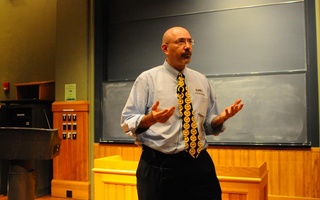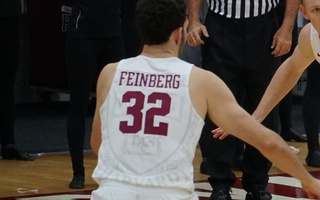The Harvard Art Museums will add about 300 works of Japanese art to its collections thanks to a gift from retired bio-organic chemistry professor and businessman Robert Feinberg ’61 and his wife Betsy, the Museums announced in a press release on Tuesday.
The donated objects, which include screens, hanging scrolls, and books dating from the 17th century to the early 20th century, will be displayed in different museums in Japan, France, and the United States before coming to Harvard in batches over the next few years. Some of the works are expected to be on permanent display in the newly renovated Fogg Museum at 32 Quincy St when the facility opens in fall 2014.
In addition to donating the Japanese art collection, the couple is also funding one of five new study spaces that will comprise a new Art Study Center at the newly renovated Fogg Museum at 32 Quincy St when the facility opens in fall 2014. The Feinberg-funded study space, which will bear the couple’s last name, will display Asian, ancient, Islamic, and eventually Indian works of art in affiliation with the now-closed Arthur M. Sackler Museum.
Speaking in a phone interview Wednesday evening, Robert Feinberg said he hopes the donated Japanese art pieces appeal to diferent constituencies across the University.
“For some students, it would be the first time they get to see Japanese art,” Feinberg said. “For those who study Japanese, I would like to see Harvard become a strong center for curators and professionals dealing with museums for generations to come.”
Feinberg said that he and Betsy Feinberg’s vast collection of Japanese art had humble beginnings. He said they bought their first piece—a $2 poster of a 16th century screen painting of a Portuguese ship arriving in Japan—while living in a small apartment in New York City in 1972.
“We were fascinated by the portrayal of the Portuguese people and their ships in the middle of the 16th century, so we bought it,” Feinberg said. “Over time, we just added more and more.”
When asked which of the many donated works was his favorite, Feinberg demured.
“We probably say a different answer depending on our mood,” he said, though he added he and Betsy Feinberg currently favor “Grasses and Moon,” a 19th century hanging scroll by Tani Bunchō, and “Cranes,” a 19th century two-panel screen by Suzuki Kiitsu.
Read more in News
Affiliates React to Supreme Court EPA Regulations CaseRecommended Articles
-
Yale Team Beats 'Cliffe Cagers, 33-22Continuing its inglorious tradition, the Radcliffe basketball team lost to Yale, 33-22, Saturday on its opponent's home ground. This defeat
-
900-Member City Union Ends Three-Day WalkoutNine hundred members of the city's largest public employees union began returning to work at 11 p.m. yesterday, 45 minutes
-
N.Y. Instructors' Affiliations Under Board's ScrutinyThe movement to winnow out "subversive teachers" from New York State schools scored a success on March 30, when the
-
 Education Reformer Talks Charter Schools
Education Reformer Talks Charter Schools -
 Robbie Feinberg
Robbie Feinberg













